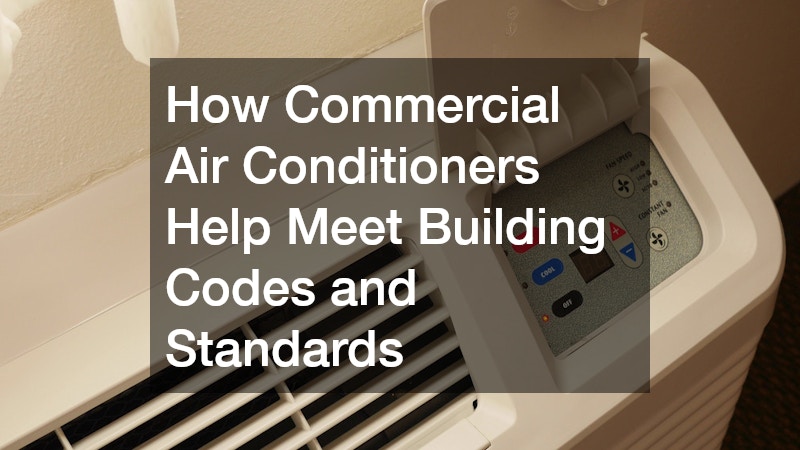A commercial air conditioner is an essential component for many businesses aiming to meet building codes and standards. These regulations ensure that buildings provide safe, healthy and comfortable environments for occupants.
Choosing the right commercial air conditioner and maintaining it properly play a significant role in complying with these requirements.
Understanding Building Codes and Standards
Building codes and standards are legal requirements set by government bodies to regulate construction, safety and energy efficiency. They cover various aspects of a building’s design and operation, including ventilation, temperature control and indoor air quality.
In many Australian states, codes such as the National Construction Code (NCC) and standards set by the Australian Building Codes Board outline specific criteria for heating, ventilation and air conditioning (HVAC) systems. These regulations aim to protect occupants’ well-being while encouraging sustainable energy use.
Temperature Control and Occupant Comfort
One of the primary functions of a commercial air conditioner is maintaining comfortable indoor temperatures. Building codes often specify temperature ranges to ensure that workplaces, retail spaces and public areas are safe and pleasant.
A properly sized and installed commercial air conditioner provides consistent cooling even in large or busy buildings. This helps meet temperature standards and creates an environment where employees and customers can function effectively without heat stress or discomfort.
Ensuring Proper Ventilation and Air Quality
Building standards require adequate ventilation to reduce indoor pollutants and maintain healthy air quality. A commercial air conditioner with advanced filtration and ventilation capabilities helps circulate fresh air and remove contaminants.
Some systems include features such as humidity control and air purification, which further enhance indoor air quality. Meeting these standards is crucial for compliance and can also reduce the risk of respiratory issues among occupants.
Energy Efficiency Requirements
Many building codes include energy efficiency standards to reduce environmental impact and operational costs. Commercial air conditioners that meet or exceed these standards contribute to lower energy consumption.
Energy-efficient units use advanced technology, such as inverter compressors and smart thermostats, to optimise performance. These features not only help buildings comply with energy regulations but also lead to long-term savings on electricity bills.
Compliance Through Professional Installation
Correct installation of a commercial air conditioner is essential for meeting building codes. Poorly installed systems may fail to provide adequate cooling or ventilation, resulting in non-compliance and possible penalties.
Hiring qualified HVAC professionals ensures that the unit is installed according to manufacturer guidelines and regulatory requirements. Professional installation includes proper sizing, ductwork, insulation and system commissioning.
Regular Maintenance for Ongoing Compliance
Maintaining a commercial air conditioner is vital to ensure it continues meeting building standards throughout its lifespan. Regular servicing helps identify and fix issues that could affect performance or safety.
Scheduled maintenance includes cleaning filters, checking refrigerant levels and inspecting electrical components. Keeping detailed records of maintenance can demonstrate compliance during inspections or audits.
Supporting Fire and Safety Regulations
Some building codes include fire safety requirements, which HVAC systems must comply with. To enhance safety, commercial air conditioners can be integrated with fire detection and suppression systems.
This integration might involve features such as automatic shutdowns or smoke detection linked to ventilation controls. Ensuring the air conditioning system supports fire safety measures is an important part of meeting building codes.
Contributing to Green Building Certifications
Beyond mandatory codes, many businesses aim for green building certifications such as NABERS or Green Star. These programs recognise buildings that exceed environmental and sustainability benchmarks.
A high-performance commercial air conditioner plays a key role in achieving these certifications by improving energy efficiency and indoor environmental quality. Investing in eco-friendly HVAC systems demonstrates corporate responsibility and can attract environmentally conscious tenants or customers.
Planning for Future Code Changes
Building codes and standards evolve over time to reflect new technologies and sustainability goals. Choosing a commercial air conditioner with upgradeable features or modular components can help buildings adapt to future requirements.
Staying informed about regulatory changes and working with HVAC experts ensures that commercial properties remain compliant and competitive in the long term.
A commercial air conditioner is much more than a comfort feature—it is a critical factor in meeting building codes and standards. Proper selection, installation and maintenance of these systems support temperature control, ventilation, energy efficiency and safety requirements. For businesses, investing in the right commercial air conditioner ensures compliance, protects occupants and promotes sustainability. Staying proactive with HVAC management helps meet current regulations and prepares buildings for the future.

